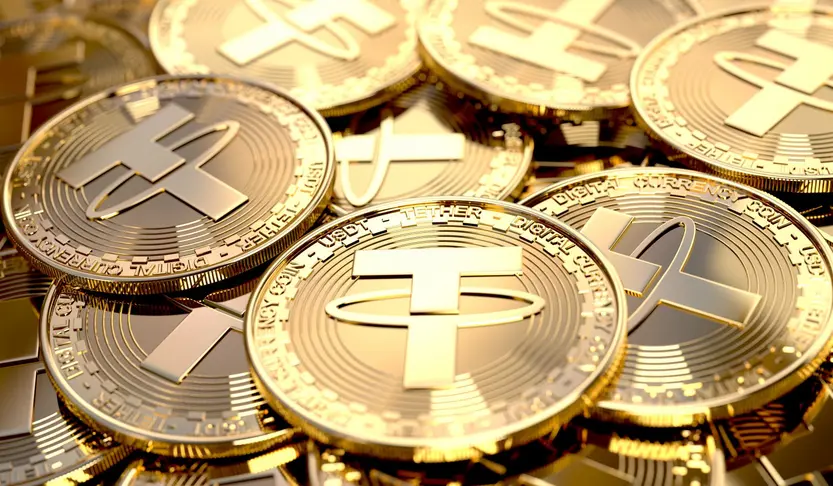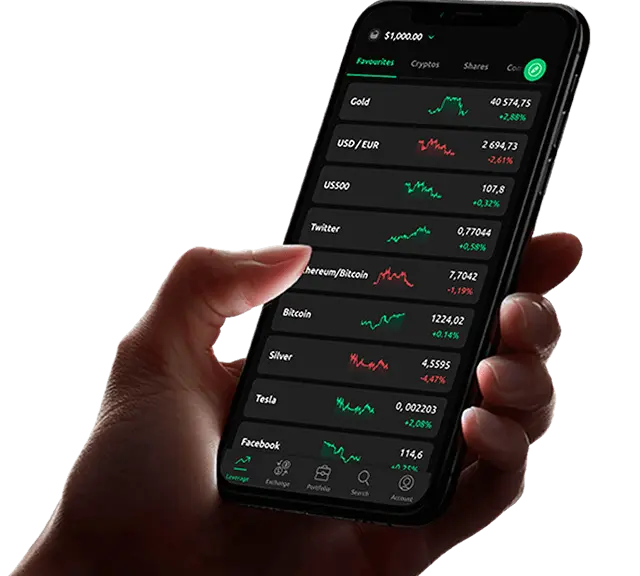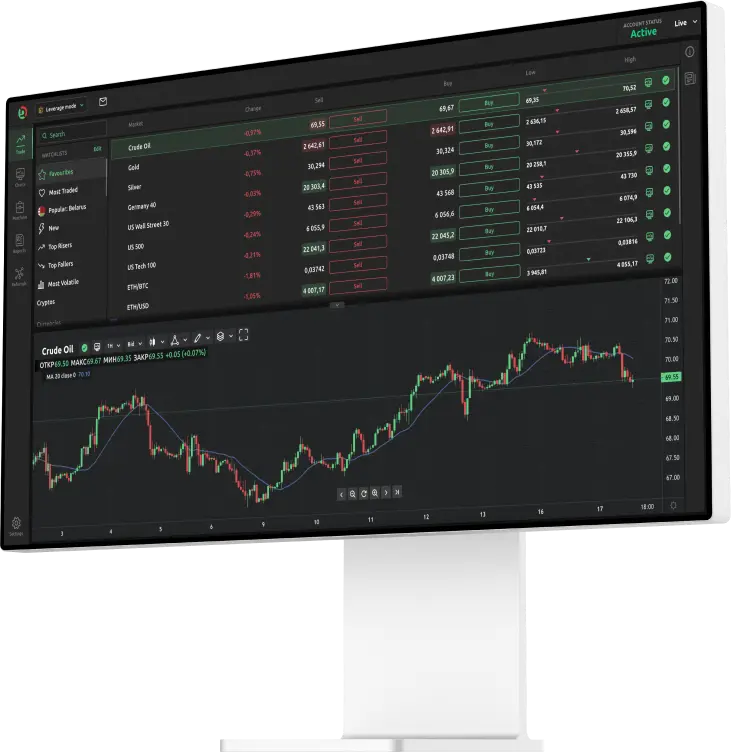Tether price predictions mean very little, as it’s pegged to $1, but its market cap has soared

Contents
- Tether reserves
- Market volume
- Forget price predictions, look at supply
- Beyond tether price predictions: company woes
- FAQs
In a world where forecasts suggest that bitcoin will be worth anything between $0 and $1m in the coming years, the tether price prediction is rather soothing. However, that does not mean an absence of dramatic news.
USDT is what is called a stablecoin. That is, it is designed to be pegged to the dollar, meaning that it constantly maintains a value of $1. Every unit that is in existence is fully backed by traditional currency that is held in reserve.
Do not let this stability fool you into thinking that the coin is dull, though. Last year in 2021, we saw the number of people investing in the coin, and the overall market cap of tether, explode.
The size of tether more than trebled in the past year, surging from $21bn on 1 January 2021 to more than $78.2bn at the time of writing on 21 January 2022.
The stablecoin has almost consistently managed to rank as the world’s third-largest cryptocurrency, behind bitcoin and ether. It is also the undisputed market leader when it comes to stablecoins, and is streets ahead of rivals such as USD coin, gemini dollar and DAI.
On 20 January, following news of a potential Russian ban on cryptocurrencies, Tether was the only coin that withstood a market ‘bloodbath’ that saw billions wiped off the value of market leaders bitcoin, ether and solana. The following day, the launch of Tether’s new streamlined mobile-compatible website saw USDT trading volume increase by 125.11% as it also began to trend on Twitter, while the rest of the market continues to suffer.
—
So, what is the tether price prediction for 2022? That’ll be $1, good sir or madam. And how is the tether prediction shaping up for 2025, 2030 and beyond? Well, assuming that it continues to remain popular among crypto investors, it is reasonable to say that the USDT price will still be $1.
We do need to ask how a coin whose value shouldn’t go up too much has increased its market cap over the past year. Well, USDT can offer a safe haven whenever the markets turn bearish, ensuring that crypto investors can exit their bitcoin positions without having to convert their capital back into fiat.
Supporters also believe that tether can have a powerful role when it comes to the remittances market, enabling dollars to be sent worldwide without punishing fees.
Tether also contributes to liquidity across the crypto markets and plays a crucial role in the blossoming decentralised finance (DeFi) sector. It is also worth noting that with the overall cryptocurrency market starting to rebound since recent crashes, more people are making use of tether as a way to trade their existing crypto assets for higher-priced coins.
For instance, just more than two out of five trades involving the solano cryptocurrency involve USDT. Furthermore, tether has minted more than two billion new coins since the start of August 2021, meaning there has been a demand for the crypto. We contacted Tether to ask about this, but did not receive a reply.
Tether reserves
Another thing that may have helped tether to grow its market cap has been the issuing of an attestation report, telling current and potential investors what was in the crypto’s reserves, as well as an explanation of the ratings and maturity of Tether’s certificates of deposit (CD) and commercial paper (CP).
For what it’s worth, as of the paper’s release on 30 July, just under half of the crypto’s reserves were in CP and CD, with around 93% rated A-2 and above and 1.5% below A-3. This news will have soothed the minds of traders who may have been concerned about the safety of the growing stablecoin.
What is interesting is the way in which tether’s market cap has shot up. On 1 January 2021, it was around $21bn. Then, in keeping with the overall growth of the cryptocurrency market at the start of last year, it grew and grew, reaching $25bn on 26 January and $30bn on 10 February. One of the key points came on 3 April, when it reached $42bn.
That meant it had doubled its market cap in the space of a little over three months. The coin did not stop there, though, and the cap was $50bn by the end of the month. Even the events of 19 May did not really hurt tether. Its market cap went down from $58.43bn to $58.12bn from 19 May to 20 May, but it was soon back up, breaking through $60bn on 25 May.
Market volume
One thing that did have an impact on the size of the market cap was when tether itself took a break from minting new coins over June and July. The stablecoin’s cap barely moved during these months compared to earlier in the year, with its cap standing at $61.79bn on 1 June and $61.81bn on 31 July. As we have seen, though, minting recommenced in August and there was some growth, with the market cap standing at $78.2bn on 21 January 2022.
Another metric to look at when it comes to tether is how much market volume it has. Interestingly, this has been on a roller-coaster ride over the summer of 2021.
For instance, on 25 July, trading volume was $45.86bn, but the following day it more than doubled to $92.45bn. On 27 July, it was back down to $67.91bn and was below $50bn on 29 July before shooting back up to $58bn on 30 July and $67.36bn on 5 August. There was some more growth and tether became the most-traded crypto in September.
At time of writing on 21 January 2022, the volume now hovers around the $75.5bn mark.
Tether is, therefore, an increasingly popular coin that is used a lot in trading. We can also see that as it becomes more popular, its market cap grows. Nevertheless, if you want some fireworks in your tether price predictions, you are probably not going to get them. If you invest $700 in USDT today, it will almost certainly be worth $700 in the years to come.
USDT’s price can fluctuate on occasion but, more often than not, these swings are often by fractions of a cent. Generally speaking, USDT manages to serve as an effective peg to the greenback, something that algorithmic stablecoins often struggle to achieve.
Forget price predictions, look at supply
Tether’s market cap has exploded in recent months, but governments around the world are starting to explore plans to launch their own central bank digital currencies (CBDCs), with China considerably ahead of the pack and piloting its digital yuan (eCNY), with a launch set for February 2022.
The US has confirmed that it intends to develop a digital dollar in the coming years but doesn’t appear to be in a rush. Would an official alternative eat into tether’s market share?
Beyond tether price predictions: company woes
In recent months, there have been some developments that could have undercut confidence in USDT’s price. One was a long-running legal dispute between Tether, its parent company Bitfinex and the New York Attorney General.
This followed allegations that USDT was not fully backed by cash reserves – and that Bitfinex took a loan from the stablecoin issuer to plug a $850m gap in its finances that was triggered by the collapse of a payment processor.
Bitfinex and Tether were subsequently ordered to pay damages of $18.5m and agreed to submit periodic updates on the state of their reserves every three months for the next two years. Both companies were also prohibited from operating in New York.
At the time, Tether said in a statement:
“Tether and Bitfinex are pleased to have reached a settlement of legal proceedings with the New York Attorney General’s Office. Under the terms of the settlement, we admit no wrongdoing. The settlement amount we have agreed to pay to the Attorney General’s Office should be viewed as a measure of our desire to put this matter behind us and focus on our business.”
The legal drama did not end up affecting the latest tether price prediction, which firmly remains at – yes, you guessed it – $1.
Further woes came on 15 October when the Commodity Futures Trading Commission fined Tether $41m to settle allegations that it lied in claiming its tokens were fully backed by fiat currencies. Bitfinex was additionally fined $1.5m.
Meanwhile, earlier in the year, Tether was in the news at the start of March after the crypto company announced on Twitter that it had been ordered to pay a ransom of 500 BTC, or else “sensitive documents” would be released. At the time of the demand, this payment would have been worth $27.5m.
Despite an outside chance that this could affect tether (USDT) price predictions, the company stood firm and said that it was refusing to bow to those demands. Tether wrote:
“It is unclear whether this is a basic extortion scheme like those directed at other crypto companies, or people looking to undermine tether and the crypto community as a whole. Either way, those seeking to harm tether are getting increasingly desperate.”
There have been some outlandish tether price predictions made elsewhere that suggest the crypto could be worth as much as $1.94 in the 12 months to come, driven by demand from institutional investors.
But the chances of such a USDT price prediction coming true are extremely slim, and although growth of 94% might seem like a good thing, it could be disastrous for an asset that has built its reputation on dependably mirroring the value of $1.
It will be interesting to see whether tether’s market cap continues to grow at breakneck speeds as 2022 kicks off.
Trade USDT to USD – USDT/USD chart
FAQs
Potentially. Because it’s a stablecoin, it should keep to a value of $1, give or take a couple of cents. That’s the point of it – it isn’t meant to make or lose money in and of itself, but rather to be a stable store of value. This is why a USDT price prediction tends to be a fairly undramatic affair compared to other cryptocurrencies.
That said, you need to do your own research, remember prices can go down as well as up, and never invest more money than you can afford to lose.
Ideally, tether should be worth $1 – that is what it is intended to do. A USDT price prediction from DigitalCoinPrice suggests it will still be $1.01 in 2025, while Gov.capital has an average tether price prediction of $3.74 for 31 December 2025.
These predictions should be taken with a pinch of salt, however. One would think that, because the USDT price is designed to be worth $1, its creators will do everything they can to peg the price to the dollar. Remember that forecasts are very often wrong, too.
If you want to buy tether, you can do so at a range of exchanges, including Dzengi.com.
Just remember to do your research and never invest more than you can afford to lose.



